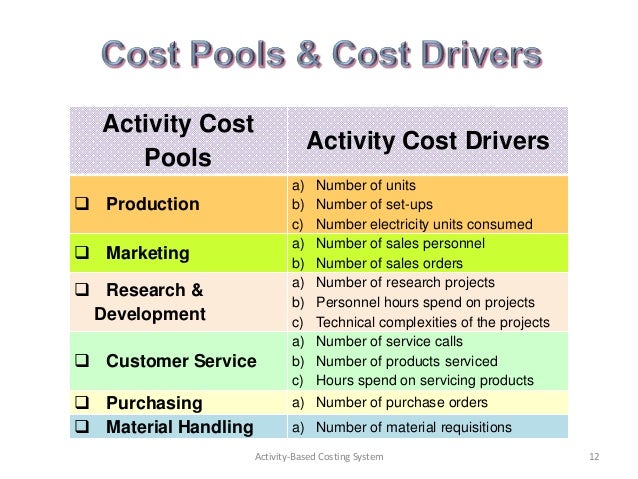
A cost driver is the unit of an activity that causes the change in activity's cost. Cost driver is any. Some examples of indirect costs and their drivers are: indirect costs for. In Customer service, cost drivers are Number of service calls attended,. For service organizations, accurate information from the company's accounting. In our cleaning company example, the driver of overhead costs in the customer.
Page/Link: Page URL: HTML link: The Free Library. Retrieved Mar 10 2019 from The current accounting literature is filled with activity based costing ABC~ articles about cost drivers in manufacturing settings but very few examples of cost driver applications in service firms or industries exist. A number of the applications of cost drivers in manufacturing plants, however, involve service functions rather than a manufactured product. Since cost driver and ABC concepts improve the cost measurement and allocation information for service departments within manufacturing firms, service firms (such as accounting or law firms) could also use cost driver and ABC concepts.
A change to cost driver techniques will provide better cost information for service firms as it has for manufacturing firms. Activity based costing will help accounting firms answer questions such as: What does it cost to prepare a tax return? What is the cost of doing an audit? How should the common costs be allocated to a particular engagement?
• It carefully examines the conflicts and allows you to quickly accept the changes. • More quick and easy comparison of file • New merge views allow the combine changes from two version of the file in a single output. Also Get: Features • Responsive, multi-threaded interface present • There are multiple windows having tabs for each comparison • Save comparisons for future use • Save workspaces • Text editor available • Drag and drop option to start comparing files • Extensive extend help tool present • Side by side display for comparison • Automatic check for the updates • Color highlighting present • Inline editing with the dynamic comparison • Ignore unimportant differences like comments, character case, headings, and line terminator style. • Mac users can now install this software on their system • The home view has now web resources as well session search • 3-way merging is now extended in a folder • Now you can easily define your unimportant text in text compare tool. Beyond compare license key generator free.

Can costs be measured better and used for pricing of services? Cost Allocations Cost allocations are arbitrary and cannot be proven correct (or incorrect) because they depend on subjective judgement and not on a verifiable cause/effect relationship.
Even though arbitrary, allocations are done in practice because the advantages outweigh the disadvantages. The methodology for making cost allocations involves two separate issues: 1. The pools or categories of indirect costs that should be identified, aggregated and allocated together. The basis over which the costs in any given pool should be allocated. It is the second issue that gives rise to the search for cost drivers or allocation bases. A number of criteria are used by companies for evaluating cost allocation methods.
Most authorities agree allocations should be made on the basis of the factors that caused the cost to be incurred. This criterion is most useful for variable costs like direct labor in an accounting or a law firm. It is less useful for fixed costs--like office rent or building depreciation--that represent a capacity decision by the firm to provide facilities for a particular level of service. Cost Drivers The most acceptable method of assigning costs to a product or service is to select drivers that approximate the underlying behavior of the costs to be allocated. This causal relationship is generally regarded as the best method for allocating indirect costs. It is the theory behind 'cost driver' methods.